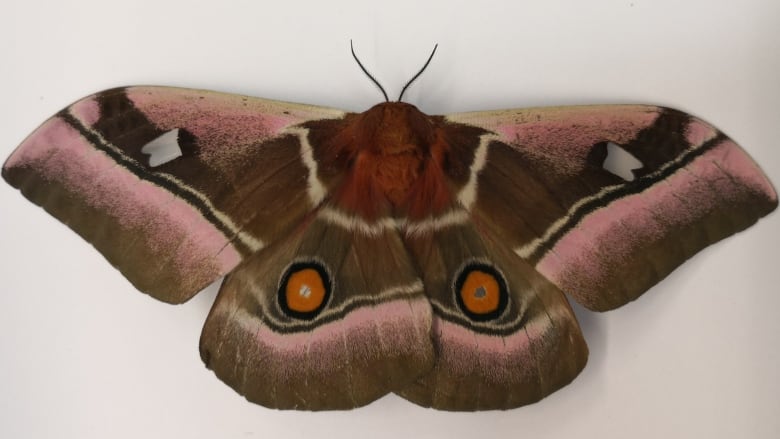
I don’t think I’ve ever seen a more gorgeous moth and it seems a perfect way to enter 2019, from a November 16, 2018 news item on CBC (Canadian Broadcasting Corporation),
A species of silk moth has evolved special sound absorbing scales on its wings to absorb the sonar pulses from hunting bats. This is analogous to the special coatings on stealth aircraft that allow them to be nearly invisible to radar.
“It’s a battle out there every night, insects flying for their lives trying to avoid becoming a bat’s next dinner,” said Dr. Marc Holderied, the senior author on the paper and an associate professor in the School of Biological Sciences at the University of Bristol.
“If you manage to absorb some of these sound energies, it would make you look smaller and let you be detectable over a shorter distance because echoe isn’t strong enough outside the detection bubble.”
Many moths have ears that warn them when a bat is nearby. But not the big and juicy cabbage tree emperor moths which would ordinarily make the perfect meal for bats.
…
The researchers prepared a brief animated feature illustrating the research,
Prior to publication of the study, the scientists made a presentation at the Acoustical Society of America’s 176th Meeting, held in conjunction with the Canadian Acoustical Association’s 2018 Acoustics Week, Nov. 5-9 at the Victoria Conference Centre in Victoria, Canada according to a November 7, 2018 University of Bristol press release (also on EurekAlert but submitted by the Acoustical Society of America on November 6, 2018),
Moths are a mainstay food source for bats, which use echolocation (biological sonar) to hunt their prey. Scientists such as Thomas Neil, from the University of Bristol in the U.K., are studying how moths have evolved passive defenses over millions of years to resist their primary predators.
While some moths have evolved ears that detect the ultrasonic calls of bats, many types of moths remain deaf. In those moths, Neil has found that the insects developed types of “stealth coating” that serve as acoustic camouflage to evade hungry bats.
Neil will describe his work during the Acoustical Society of America’s 176th Meeting, held in conjunction with the Canadian Acoustical Association’s 2018 Acoustics Week, Nov. 5-9 at the Victoria Conference Centre in Victoria, Canada.
In his presentation, Neil will focus on how fur on a moth’s thorax and wing joints provide acoustic stealth by reducing the echoes of these body parts from bat calls.
“Thoracic fur provides substantial acoustic stealth at all ecologically relevant ultrasonic frequencies,” said Neil, a researcher at Bristol University. “The thorax fur of moths acts as a lightweight porous sound absorber, facilitating acoustic camouflage and offering a significant survival advantage against bats.” Removing the fur from the moth’s thorax increased its detection risk by as much as 38 percent.
Neil used acoustic tomography to quantify echo strength in the spatial and frequency domains of two deaf moth species that are subject to bat predation and two butterfly species that are not.
In comparing the effects of removing thorax fur from insects that serve as food for bats to those that don’t, Neil’s research team found that thoracic fur determines acoustic camouflage of moths but not butterflies.
“We found that the fur on moths was both thicker and denser than that of the butterflies, and these parameters seem to be linked with the absorptive performance of their respective furs,” Neil said. “The thorax fur of the moths was able to absorb up to 85 percent of the impinging sound energy. The maximum absorption we found in butterflies was just 20 percent.”
Neil’s research could contribute to the development of biomimetic materials for ultrathin sound absorbers and other noise-control devices.
“Moth fur is thin and lightweight,” said Neil, “and acts as a broadband and multidirectional ultrasound absorber that is on par with the performance of current porous sound-absorbing foams.”
Moth fur? This has changed my view of moths although I reserve the right to get cranky when local moths chew through my wool sweaters. Here’s a link to and a citation for the paper,
Biomechanics of a moth scale at ultrasonic frequencies by Zhiyuan Shen, Thomas R. Neil, Daniel Robert, Bruce W. Drinkwater, and Marc W. Holderied. PNAS [Proccedings of the National Academy of Sciences of the United States of America] November 27, 2018 115 (48) 12200-12205; published ahead of print November 12, 2018 https://doi.org/10.1073/pnas.1810025115
This paper is behind a paywall.
Unusually I’m going to include the paper’s abstract here,
The wings of moths and butterflies are densely covered in scales that exhibit intricate shapes and sculptured nanostructures. While certain butterfly scales create nanoscale photonic effects [emphasis mine], moth scales show different nanostructures suggesting different functionality. Here we investigate moth-scale vibrodynamics to understand their role in creating acoustic camouflage against bat echolocation, where scales on wings provide ultrasound absorber functionality. For this, individual scales can be considered as building blocks with adapted biomechanical properties at ultrasonic frequencies. The 3D nanostructure of a full Bunaea alcinoe moth forewing scale was characterized using confocal microscopy. Structurally, this scale is double layered and endowed with different perforation rates on the upper and lower laminae, which are interconnected by trabeculae pillars. From these observations a parameterized model of the scale’s nanostructure was formed and its effective elastic stiffness matrix extracted. Macroscale numerical modeling of scale vibrodynamics showed close qualitative and quantitative agreement with scanning laser Doppler vibrometry measurement of this scale’s oscillations, suggesting that the governing biomechanics have been captured accurately. Importantly, this scale of B. alcinoe exhibits its first three resonances in the typical echolocation frequency range of bats, suggesting it has evolved as a resonant absorber. Damping coefficients of the moth-scale resonator and ultrasonic absorption of a scaled wing were estimated using numerical modeling. The calculated absorption coefficient of 0.50 agrees with the published maximum acoustic effect of wing scaling. Understanding scale vibroacoustic behavior helps create macroscopic structures with the capacity for broadband acoustic camouflage.
Those nanoscale photonic effects caused by butterfly scales are something I’d usually describe as optical effects due to the nanoscale structures on some butterfly wings, notably those of the Blue Morpho butterfly. In fact there’s a whole field of study on what’s known as structural colo(u)r. Strictly speaking I’m not sure you could describe the nanostructures on Glasswing butterflies as an example of structure colour since those structures make that butterfly’s wings transparent but they are definitely an optical effect. For the curious, you can use ‘blue morpho butterfly’, ‘glasswing butterfly’ or ‘structural colo(u)r’ to search for more on this blog or pursue bigger fish with an internet search.
